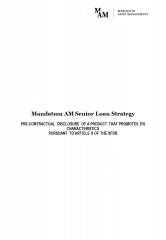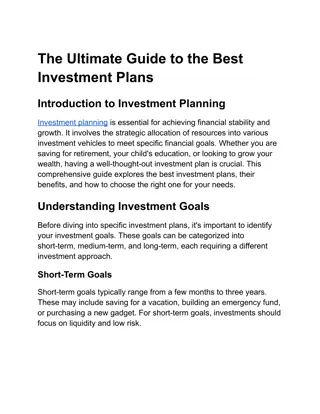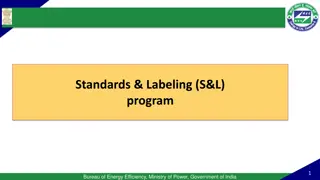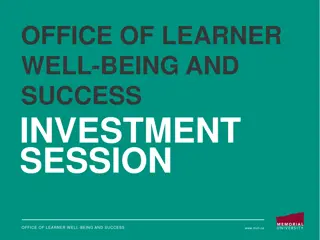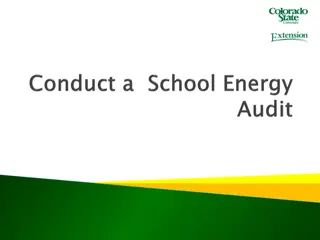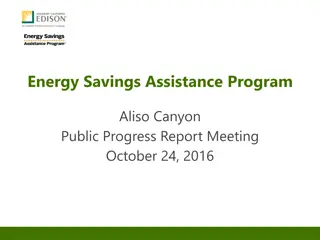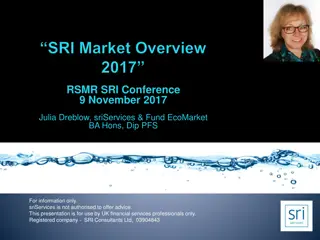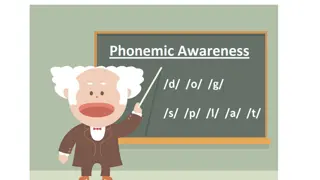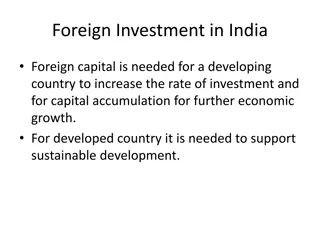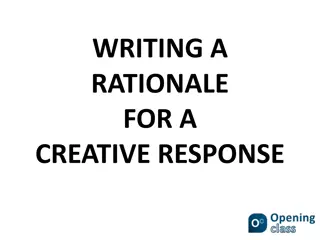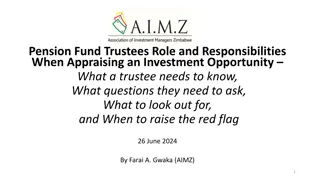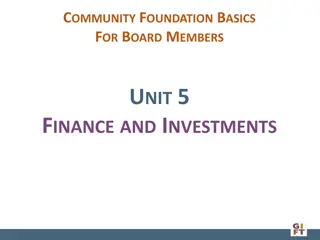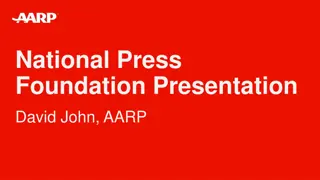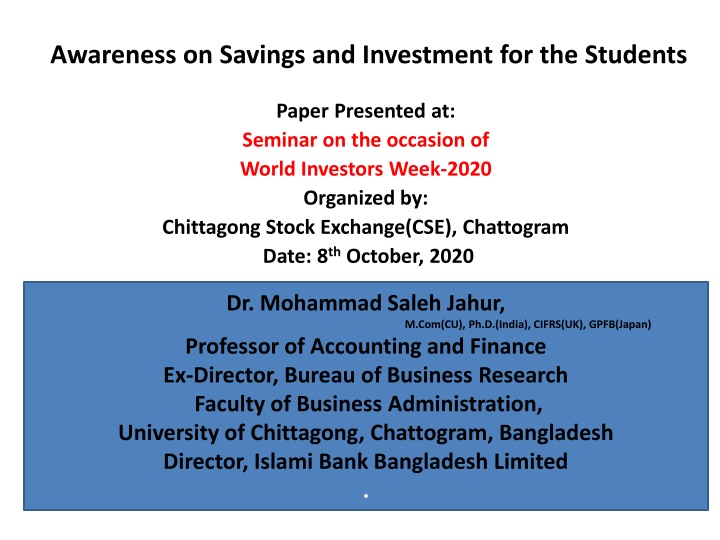
Awareness on Savings and Investment for Students - A Rationale
Savings and investment are vital for economic and social well-being. This paper explores the importance of financial literacy, personal interest, and environmental factors in influencing students' awareness of savings and investment.
Download Presentation

Please find below an Image/Link to download the presentation.
The content on the website is provided AS IS for your information and personal use only. It may not be sold, licensed, or shared on other websites without obtaining consent from the author. If you encounter any issues during the download, it is possible that the publisher has removed the file from their server.
You are allowed to download the files provided on this website for personal or commercial use, subject to the condition that they are used lawfully. All files are the property of their respective owners.
The content on the website is provided AS IS for your information and personal use only. It may not be sold, licensed, or shared on other websites without obtaining consent from the author.
E N D
Presentation Transcript
Awareness on Savings and Investment for the Students Paper Presented at: Seminar on the occasion of World Investors Week-2020 Organized by: Chittagong Stock Exchange(CSE), Chattogram Date: 8thOctober, 2020 Dr. Mohammad Saleh Jahur, M.Com(CU), Ph.D.(India), CIFRS(UK), GPFB(Japan) Professor of Accounting and Finance Ex-Director, Bureau of Business Research Faculty of Business Administration, University of Chittagong, Chattogram, Bangladesh Director, Islami Bank Bangladesh Limited .
Savings and Investment for Students-A Rationale These two integral components are essentials to everybody s economic and social life. Inbuilt Capacity: Career Development of students irrespective of subjects and standards of livings are significantly affected by savings and investment practices; Financial Inclusion: One can be a Part of stream of economy through savings and investment; World Class Financial Citizen: This is the need of today s modern art of technology; Otherwise one lags behind. Knowledge: Knowing how to secure your financial well-being is one of the most important things you ll ever need in life. Learning through practice and Value: You don t have to be a genius to do it. You just need to know a few basics, form a plan, and be ready to stick to it. Exploiting Opportunity: No matter how much or little money you have, the important thing is to educate yourself about your opportunities. Way Forward: Awareness on Savings and Investment
Awareness of students on Savings and Investment for Students-A Rationale Saving is a prerequisite for investment. While making an investment activity, investors normally tolerate the sacrifice of certain present value for the uncertain future reward. It could entail arriving numerous decisions, such as what type of instruments/assets to be invested, mixed instruments, the amount of investment, timing consideration, and etc. A standard finance theory assumes that investor decision towards investment must be made rationally, while the behavioral finance assumes that the investors are basically deviated from rational decision making (Sewwandi, 2015). People easily fall into confusion between savings and investment, while thinking about the investment as a means of savings. This becomes as one of the factors to reduce the tendencies of making investment among people (Lokhande, M. A., 2015). The variable like awareness, income level, and skills play a mainstream role which might influence young generation/students to invest in some specific financial instruments/assets. One thing is clear that investment could generate an income to the investor if it is properly managed, and the right investment tool is chosen and timely monitored.
Awareness of students on Savings and Investment for Students-A Rationale Awareness on savings and investment is significantly and positively influenced by three factors: I. Financial Literacy; II. Personal Interest- Supportive Income; and III. Environment- Rules & Regulations. A student with knowledge skills, technological skill, analytical skills, and communication skill in these areas can be able to save and use of a part of savings through managing expenses in the form of investment to make return/profit/utility/surplus/yield/money as expected. No one can guarantee that you ll make money from investments you make. But if you get the facts about saving and investing and follow through with an intelligent plan, you should be able to gain financial security over the years and enjoy the benefits of managing your money. So, students should be aware of savings and investment to be world class financial citizen.
Financial Literacy for Students-Concepts Financial literacy can be defined as the ability to read, interpret and analyze, manage the money, communicate about personal financial conditions that affect material well-being, compute, develop independent judgment, and take actions resulting from those processes in order to thrive in our complex financial world. Financial literacy gives university students capacity to prevent them from the tendency being trapped with extensive debts, especially the credit card debts (Azizah, 2013). The financial literacy gives university students capacity to prevent them from the tendency being trapped with extensive debts, especially the credit card debts (Azizah, 2013). Financial literacy provides knowledge skills, analytical skills, and decision making skills
Financial Literacy Knowledge and skills about personal planning and management of income and savings. Basic understanding to assess the suitability of various financial products and investment opportunities available in the financial markets. Awareness and ideas about access to financial services and availability of various types of products and their features. Understanding consumers rights and obligations, risk and return potentials related to investments opportunities. Changed attitude to translate knowledge into responsible financial behavior.
Why Financial Literacy? Ensuring self-protection from financial frauds. Building a financially secured future. Preparing for emergencies by incorporating contingencies in financial plan. Making an individual more responsible with a disciplined approach to money. Understanding alternative financial products, their risks and returns. Understanding basic financial concepts. Developing skills and confidence.
Common Behavior of Ignorant Investors Invest without proper knowledge and assessment about the risks of financial markets and products. Invest in risky products for utopian abnormal benefits. Invest without assessing own capacity and risk bearing ability. Speculative and rumor-based decision making and investment without proper analysis. Invest in high market price and panicky divest when price declines. Take high cost debt without assessing repayment ability. No specific plan of savings and investment. Invest all in a single or similar product. Attitude to follow big investors. Herd behavior. Invest without searching for alternatives.
Investment -Fundamentals Definition: Investment is the tying of funds to assets for making profit. Investment is the activity of generating surplus. Investment is the commitment of funds (cash, equity and loan) to assets Financial Assets and Real Assets for a particular periods (Investment period-Short and Long ) with an anticipation of receiving larger cash flows (objective of investment) in the future (Harvesting Period). Features : An investment is characterized by following features: F1: Availability of Funds: Investment is the commitment of funds-cash, equity and loan; F2: Investible Assets: to assets Financial Assets and Real Assets F3: Investment period-Shortand Long: Definite Period or indefinite period; F4: Investment Objective: With an anticipation of receiving larger cash flows-objective of Investment F5: Harvesting Period.
Types of Investors 1.Individual Investor and 2. Institutional Investors-Dealer, Mutual Fund, Merchant Banker, Banks, and Insurance 1. Risk Neutral /Conservative Investors- No risk and a secured return 2. Risk Averse/Moderate Investors- Minimum Risk and Maximum Return 3. Risk Taker/Aggressive Investors-High Risk and High Return 1.Short Term Investors and 2. Long Term Investors 1. Primary Market Investors 2. Secondary Market Investors 3. Mixed Investors 1. Investors willing to make profit on a regular basis and 2. Investors willing to make capital gain 1. General Investors and 2. Natural Investors 1.Equity Investors and 2. Bond Investors
Forms of Investment Investment in Financial Assets Investment in Real Assets 1.Equity Claim Direct -Equity/common stock -Option -Warrant 2.Equity Claim-Indirect - Mutual Fund/Unit Certificate; -Money Market Fund, - Pension Fund, Exchange Traded Fund, wtc. 1. Creditors Claim - Deposit - Treasury Bill/Notes/Bonds, -National Saving Certificates, -Corporate Bond/Debentures, - Commercial Paper, -Assets Backed Securities, - Banker s Acceptance; -Others 1. Preference Share 5.Financial Derivatives - Forward -Futures -Option -Swap 1. Real Estate -Land/Building/Apartment/Duplex -Furniture, -Vehicle -Machineries, etc. 2. Precious Metal -Gold, -Silver 3.Precious Gems - Diamond -Ruby, etc. 1. 5.Others -Spices -Oil -Cattles -Living Hogs -Agro Products, etc. Collectibles: -Arts, -Antiques
Investment on Market Basis-Bangladesh Perspective Money Market Govt. Borrowings Capital Market Real Assets Market-Real Estate, precious metal, Precious Gems, Collectibles, and others. Share Bond Debenture Mutual Fund ETF Alternative Investment Funds Asset Based Securities Derivatives Other Structured Products SUKUK Current Savings Short Term Deposit Fixed Deposit Pension Scheme Islamic Deposit Schemes Other Deposit Scheme Treasury Bonds Postal Deposit Schemes Jatio Shanchay patra Wage Earners Bond Other Scheme Insuranc e Different Insurance Schemes 12
Financial System MOF BSEC IDRA MCRA BB Micro Capital Market Insurance Money Market Credit Equity, Bond, Debenture, ABS, ETF Current Savings STD Exchange Depository CCP Insurance Company Bank MCI Insurance Policies MF, VC, PE, IF,SUKUK Microcredit Products FDR, DPS Other Products Broker, MB. AMC, FM, CRA, DP, Trustee Etc. NBFI Company Govt. Other Issuer Derivative, Structured Product Regulators Financial Markets Government Financial Instruments Financial Institutions 13
Capital Market Mechanism General Investors Government Exchange Institutional Investors Brokerage DSE Investment Banks Professional Fund Manager Foreign Investors CSE Corporate Intermediaries Government Investors Investees
Investors (Providers of Fund) Any individual with a BO account. Invests to make wealth for him/herself Usually not sophisticated General Investors Usually Financial Institutions Invests to make wealth for the institution Usually sophisticated Institutional Investors Usually Frontier and Emerging Market Fund Managers and Hedge Funds Invests to make wealth for global investors pool Highly sophisticated Foreign Investors Government of Bangladesh Invests for Strategic Purposes Strategy driven Government
Investee (Users of Fund) Wants Capital for development or day to day Government operations Wants to help the market develop Consumer Credit/Household Credit/Education/Marriage/Pilgrimage Credit, etc. Individual/Househ old Wants Capital to expand Wants the market to discover its true value Wants to create liquidity for its share, so that Corporate new investors can enter and old one exit, if they want
Capital Market-Where to invest? Security Market Secondary Market Primary Market Organized Secondary Market CSE/DSE Over-the- Counter Market- CSE/DSE
Primary Market-Functions Primary Security Market facilities issuing securities for raising funds for financing both long term capital and working capital. Parties to the Primary Market: I. Regulator-BSEC; II. Issuing Company-Public Limited Company; III. Exchange -CSE/DSE; IV. Managers- Issue Managers/Underwriter/Registrar/Bankers to the issue; V. Custodian: Central Depository Bangladesh Limited. VI. Investors-Individuals-Local and NRBs and Institutional Investors-Dealers/Mutual Fund/Merchant Bankers/Banks/Insurance; VII. Functional Agents: Credit Rating Company/Chartered& Cost Accountancy Firms/Valuation Agents/EEE of BUET
SECONDARY SECURITY MARKET-FUNCTIONS Basic function of the Secondary Market like CSE facilitates buying and selling shares and securities between buyers and sellers either through brokers or direct at competitive price during trading hours of the working days across year. Parties involved in the Secondary Market: a) Exchange CSE/DSE; b) Brokers for Buyer and Sellers c) Dealers d) Depository Participants e) Investors f) Custodian-Central Depository Bangladesh Limited. Generally, Secondary Security Market performs following functions: Liquidity Efficiency Consistency and Continuity.
Comparison between Capital Market & Money Market Capital Market: 1. It provides finance/money capital for long-term investment. 2. The finance provided by the capital market may be used both for fixed and working capital. 3. Mobilization of resources and effective utilization of resources through lending are its main functions. 4. It s one of the constituents, Stock Exchange acts as an investment market for buyers and sellers of securities. 5. It acts as middleman between the investor and the entrepreneur. 6. Underwriting is one of its primary activities. 7. Its investment institutions raise capital from public and invest in selected securities so as to give the highest possible return with the lowest risk. 8. It provides long-term funds to Central and State Governments, public and local bodies for development purposes. Money Market: It provides finance/money for short-term investment. The finance provided by money market is utilized usually for working capital. Lending and borrowing are its principal functions to facilitate adjustment of liquidity position. It does not provide such facilities. The main components include call loan market, collateral loan market, and bill market and acceptance houses. It acts as a link between the depositor and the borrower. Underwriting is a secondary function. It provides outlets to commercial banks, business corporations, non-bank financial concerns and others for their short-term surplus funds. It provides short-term funds to Government by purchasing treasury bills and to others by discounting bills of exchange, etc. 1. 2. 3. 4. 5. 6. 7. 8.
Objective of Investment To make return; To make return; To make surplus; To make money; To make yield and return; To doubling or trebling money. To ideal Investor-To make maximum return/ profit.
Criteria of Making Investment Decision Two Criteria: Return and Risk Risk: Financial Risk Operating Risk Equity Risk Market Risk: Interest Rate Risk Inflation Rate Risk Exchange Rate Risk Unit Value Risk Liquidity Risk Technological Risk Regulatory Risk Return- Total Return; Return Return Warrnat Total Return Mean Return Portfolio Return Market Return
Financial Plan- Financial plan is the projected plan of an investor. Financial planning is a method of projecting Financial Budget-Cash Budget, Sales Budget, Purchase Budget, Production Budget (Taka and Unit), Overhead Budget, Investment Budget, Capital Expenditure Budget, etc.) Financial Statements (Components): Income Statement; Cash Flow Statement; Financial Position/Balance Sheet; Statement of Change in Equity; Notes to the Financial statement on the basis of target/objective;
Financial Plan-Steps A. SET YOUR FINANCIAL GOALS If you don t know where you are going, you may end up somewhere you don t want to be. To end up where you want to be, you ll need a roadmap, a financial plan. What do you want to save or invest for? By when? 1.------------------- 2.--------------------- 3.---------------------- 4.-------------------------- -------------------- ----------------
B. KNOW YOUR CURRENT FINANCIAL SITUATION Sit down and take an honest look at your entire financial situation. You can never take a journey without knowing where you re starting from, and a journey to financial comfort is no different. You ll need to figure out on paper your current situation what you own and what you owe. You ll be creating a net worth statement. On one side of the page, list what you own. These are your assets. And on the other side list what you owe other people, your liabilities or debts. Assets Current Value Liabilities Amount Cash __________ Credit cards __________ Checking accounts __________ Bank loans __________ Savings _________ _ Car loans __________ Other investments _________ _ Student loans __________ Personal property _ ______ Other __________ TOTAL ____ ______ TOTAL _______
C. KNOW YOUR INCOME AND EXPENSES The next step is to keep track of your income and your expenses for every month. Write down what you earn, and then your monthly expenses. Find money to save or invest-Small Savings Add Up to Big Money Pay off Credit Card or other high interest debt; Put Away the Plastic; Know What You Owe; Pay Off the Card with the Highest Rate;
Making Money Grow Two ways to make money 1.You work for money. Someone pays you to work for them or you have your own business. 2.Your money works for you. You take your money and you save or invest it.
Where to invest your savings? When you invest, you have a greater chance of losing your money than when you save. The money you invest in securities, mutual funds, and other similar investments typically is not insured. You could lose your principal the amount you ve invested. But you also have the opportunity to earn more money. WHY SOME INVESTMENTS MAKE MONEY AND OTHERS DON T You can potentially make money in an investment in a company if: The company performs better than its competitors. Other investors recognize it s a good company, so that when it comes time to sell your investment, others want to buy it. The company makes profits, meaning they make enough money to pay you interest for your bond, or maybe dividends on your stock.
How to select security for investment? Investors should consider following factors while selecting security for investment: Investors Fundamental Features of Security Risk and Safety of Principal; Liquidity Short Term Vs Long term Oriented; Total Return vs Yield; Tax Plan; Financial Plan; Ease of Management Earning Momentum; Value; Growth in Assets, Sales, Capital, and Profits Growth at Reasonable Growth in P/E Ratio>=< Growth Rate
Security Market Environment for Investment Regulator: Bangladesh Securities Exchange Commission-Enforces Law in the capital market; Market-CSE/DSE-provides automated floor for transaction of shares; CDBL-works as custodian of sharesand securities; Transaction of share and Securities- Automation/Internet based transaction; Categories of Share-Five Categories: A-B-G-N-Z Settlement of A Category Transaction: T + 2 Types of Order: Market Order + + Form of Share: Electronic Form of Shares; Price- Opening Price-Closing Price-High Price- Low Price Number of Securities Listed with CSE- 331 Stock Indices for Market Performance-Five-CSE-30 Index/CSCX Index/CSEAShare Price index/CSE Shariah Index. Shares and Securities: Equity Share/Unit Certificate/Corporate Bond/ Treasury Bonds(OTC Market)
THANKS FOR DEVOTING TO THE DELIBERATION MADE ON THE OCCASION OF WORLD INVESTORS WEEK-2020.

